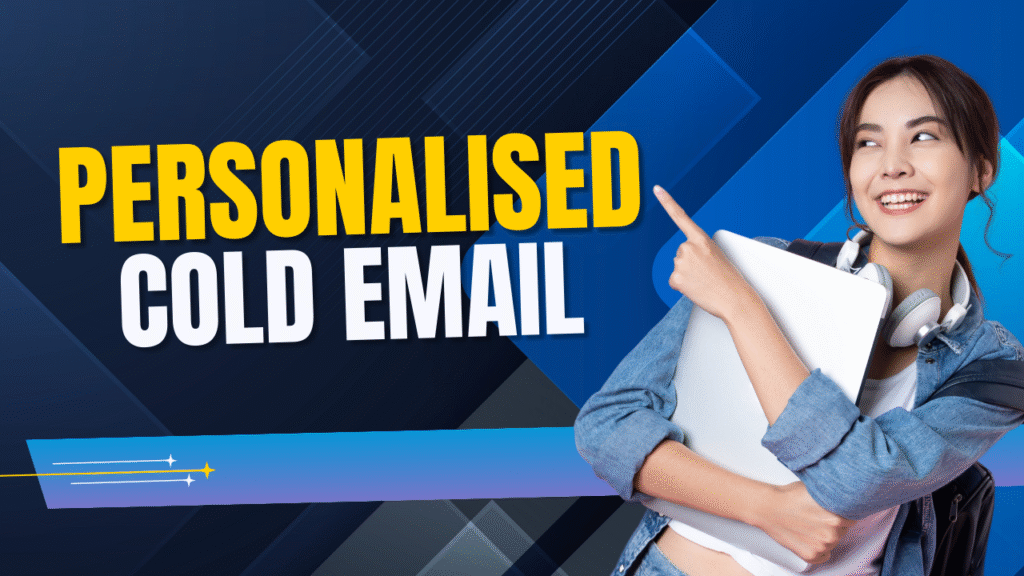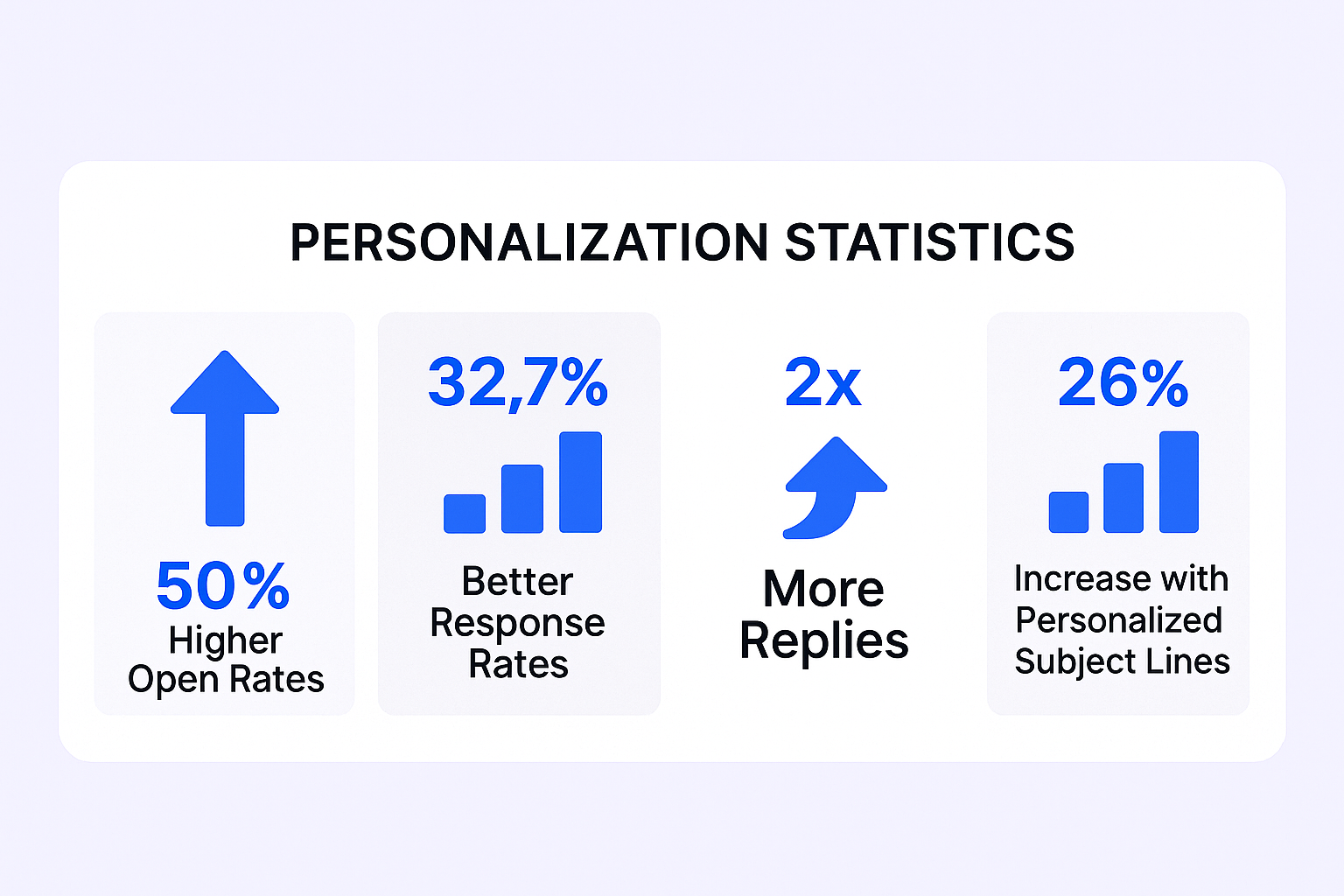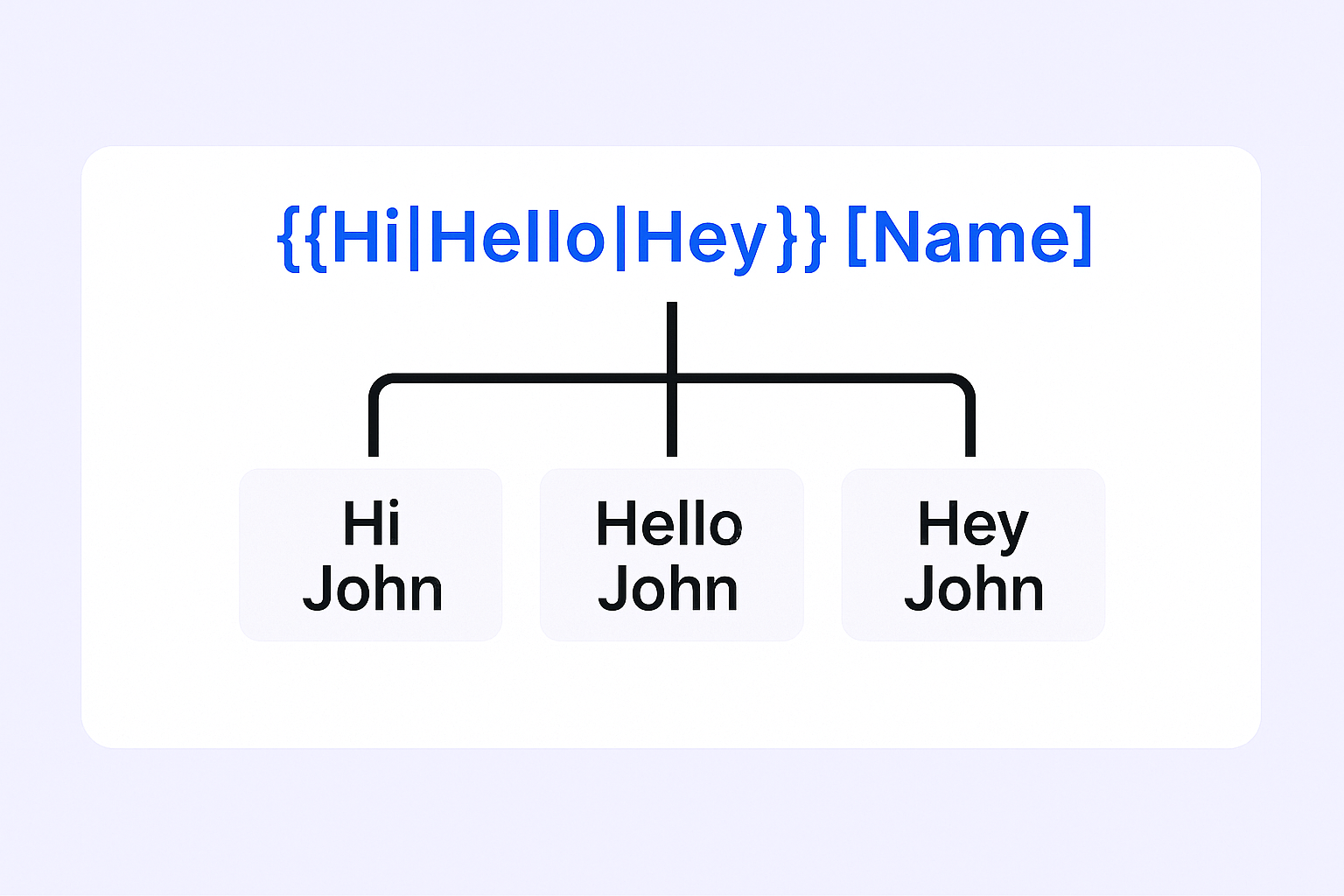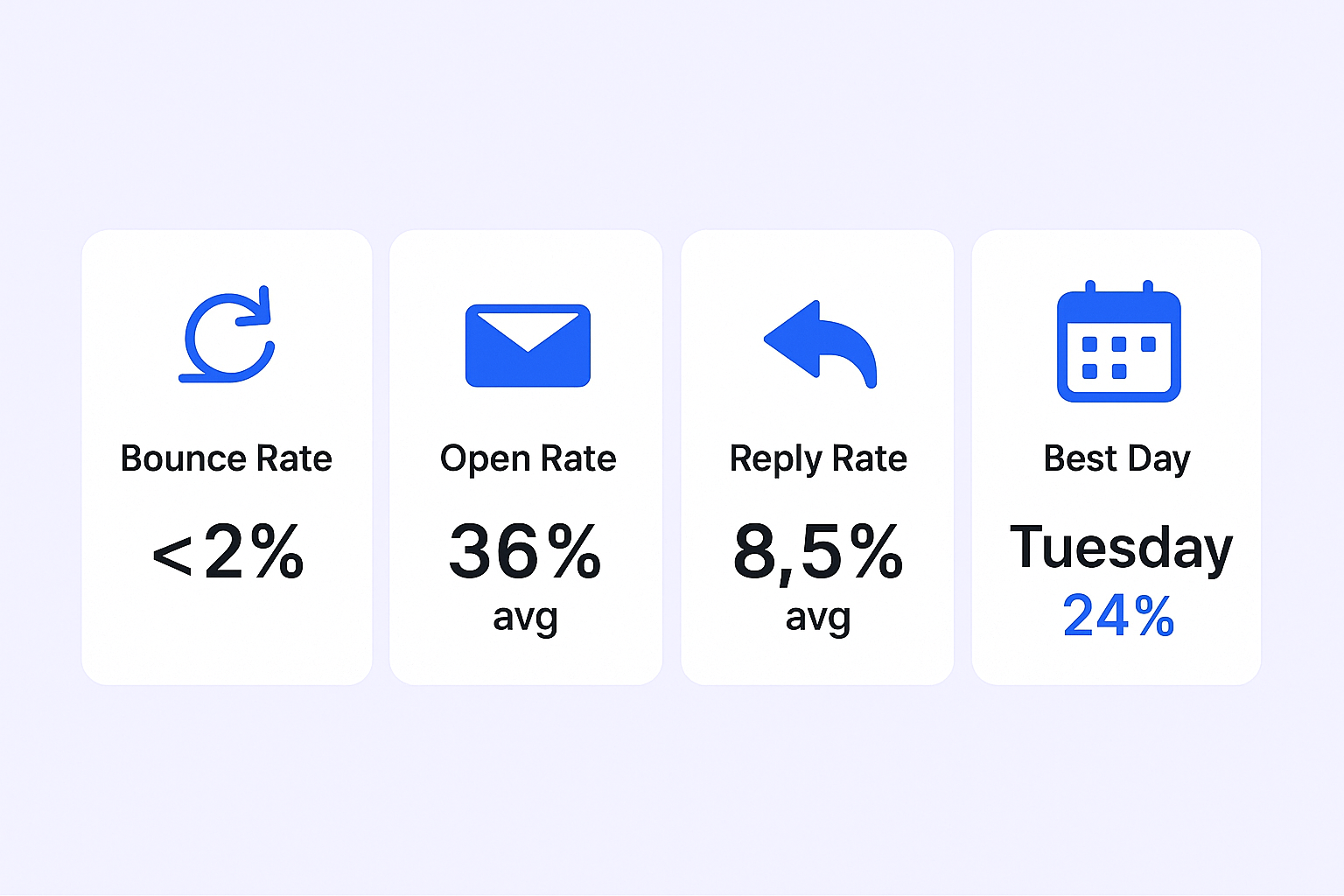- blog
- Cold Emailing
- Personalised Cold Email Guide: Boost Response Rates 2025

Master Personalised Cold Email: The Complete Guide to Skyrocketing Response Rates in 2025
Table of Contents
Introduction to Cold Emailing
As a BDR or AE, you’ve likely experienced the frustration of sending cold emails that seem to disappear into the digital void. You craft what you think is a compelling message, hit send, and then… silence. The harsh reality is that the average cold email click-through rate is around 2-5%, which means most of your efforts aren’t generating the results you need.
But here’s the thing – cold emailing isn’t dead. In fact, cold email marketing has a 2x higher ROI than cold calling or trade shows, and the ROI of a cold email is $42 for every $1 spent. The secret isn’t abandoning cold emails; it’s mastering personalised cold email strategies that cut through the noise and actually get responses.
The old “spray and pray” approach of sending generic templates to hundreds of prospects simply doesn’t work anymore. Personalized subject lines generate 50% higher email open rates, and personalized email content increases average cold email response rates by 32.7%. This guide will show you exactly how to leverage personalization to transform your cold email outreach from a numbers game into a relationship-building powerhouse.
What are Cold Emails and When to Use Them
A cold email is an unsolicited message sent to someone you’ve never interacted with before. Unlike spam, cold emails are targeted, personalized, and provide genuine value to the recipient. They’re your digital equivalent of a cold call, but with one major advantage – they give prospects time to consider your message without feeling pressured.
Cold emails are incredibly versatile and can be used for:
- Prospecting new clients for your products or services
- Building partnerships with other businesses in your industry
- Networking with industry leaders and potential mentors
- Content promotion to relevant audiences
- Recruiting top talent for your organization
The key difference between cold emails and spam lies in relevance and personalization. While spam is generic and mass-distributed, effective cold emails are researched, targeted, and tailored to each recipient’s specific needs and interests.
Legal compliance is crucial when sending cold emails. In the US, you must follow the CAN-SPAM Act, which requires clear sender identification and easy unsubscribe options. In Europe, GDPR regulations mandate explicit consent for most email marketing. Always include your business name, address, and a clear unsubscribe link to stay compliant.
The Benefits of Cold Email Personalization
The statistics don’t lie – personalization is the single most important factor in cold email success. Personalized emails receive more than twice as many replies as non-personalized ones, making the investment in customization well worth your time.
Here’s what personalization can do for your cold email campaigns:
Dramatically Increased Response Rates: Personalized email content increases average cold email response rates by 32.7%. Some companies using hyper-personalization have seen response rates jump by up to 300%.
Higher Open Rates: Personalized subject lines can increase open rates by up to 26%. 33% of people open emails based on the subject line, making this your first critical touchpoint.
Better Click-Through Rates: Personalized CTA performs 202% better than non-personalized, and using a clear call-to-action can increase response rates by up to 371%.
Improved ROI: 89% of marketers see a positive ROI when they use personalization in their cold email campaigns. Some companies generate 40% more revenue from personalized campaigns compared to generic ones.
Enhanced Deliverability: Personalized emails are less likely to be marked as spam because they demonstrate genuine research and relevance. This helps maintain your sender reputation and ensures your messages reach the inbox.
💡 Stop Perfecting Cold Email Research
Our LinkedIn outbound system transforms strangers into warm connections who welcome your messages
Best Practices for Cold Email Personalization
Use Spintags
Spintags (also called Spintax) are your secret weapon for creating unique emails at scale. This technique uses curly brackets {} and pipe separators | to create multiple variations of the same text. For example: {{Hi|Hello|Hey}} John creates three different greeting options.
Here’s how to implement spintags effectively:
Greetings: {{Hi|Hello|Hey}} [First Name] Opening Lines: I came across your {{work|profile|company}} and was really impressed Pain Points: Many [Industry] professionals struggle with {{time-consuming processes|scattered data|outdated tools}} Calls to Action: Would you {{like to learn more|be interested in hearing about}} our solution?
Spintags help you avoid spam filters by preventing repetitive content while maintaining a natural, human tone. For maximum effectiveness, use nested spintax: {Hey|Hello|Hi} {{First_Name}}, I saw {your {recent post|latest update} on LinkedIn|the work you’re doing at {{Company}}} and {was impressed|found it really interesting}.
Highlight Mutual Connections
Mentioning shared connections instantly builds trust and credibility. Research has shown simply including a recipient’s name or the name of their company in the email can boost the average response rate to over 9%.
Effective strategies include:
- LinkedIn mutual connections: “Hi [Name], [Mutual Connection] suggested I reach out…”
- Shared alma mater: “I noticed we’re both [University] alumni…”
- Industry associations: “I saw you’re also a member of [Professional Organization]…”
- Common interests: “I noticed you also follow [Industry Leader] on LinkedIn…”
This approach immediately eliminates the “stranger barrier” and positions you as a peer rather than just another salesperson.
Use a Candidate’s Name More Than Once
Beyond the subject line, strategically weaving the prospect’s name throughout your email creates a more personal connection. However, avoid overdoing it – natural integration is key.
Effective examples:
- “I think this solution could really help [First Name]’s team achieve their goals”
- “Based on [First Name]’s background in [Industry], I thought you’d find this interesting”
- “I’d love to get [First Name]’s thoughts on this approach”
The key is using their name when referring specifically to their work, challenges, or achievements, not just randomly inserting it throughout the message.
Using Personalised Language
True personalization goes beyond merge tags – it’s about speaking directly to the recipient’s world. This involves:
Research-driven personalization:
- Recent company news or achievements
- Industry-specific challenges they’re likely facing
- Their role-specific pain points and goals
- Content they’ve published or shared
Industry-specific terminology: Use language that shows you understand their business. If you’re reaching out to a CFO, focus on ROI and cost efficiency. For a marketing director, emphasize growth metrics and conversion rates.
Pain point addressing: Show you understand their specific challenges. Instead of generic problems, reference the exact issues someone in their position faces.
<div style=”border: 2px solid #007acc; background-color: #f0f8ff; padding: 20px; margin: 20px 0; text-align: center;”>
🚀 Skip The Personalization Struggle
LinkedIn relationship building achieves 40% response rates while personalized cold emails peak at 32.7%
Send Your Email at the Perfect Time
Even the most personalized email can fail if it arrives at the wrong time. The best time to send a cold email is between 5 AM and 8 AM on Monday, where cold emails get an average reply rate of 2.3%.
Optimal timing guidelines:
- Best days: Tuesday through Thursday typically see the highest engagement
- Best times: 8-11 AM and 4-6 PM in the recipient’s local timezone
- Avoid: Mondays (overcrowded inboxes), Fridays (weekend mode), and weekends
Emails sent on Tuesdays have a 24% open rate, the highest weekday, making it your sweet spot for important outreach.
Pro tip: Always adjust for the recipient’s timezone. If you’re targeting a broad US audience, Eastern time is often safe since approximately 50% of the US population is in that timezone.
Compliment a Piece of Content Developed by a Prospect
This is perhaps the most powerful personalization tactic because it shows genuine interest in their work. 36% of people said a longer, personalized email containing their name would make them more likely to respond.
How to do it effectively:
- Reference a specific blog post, LinkedIn article, or podcast appearance
- Mention a particular insight that resonated with you
- Explain how their content influenced your thinking or approach
- Connect their expertise to your offering naturally
Example: “I really enjoyed your recent article about scaling sales teams. Your point about the importance of process documentation really resonated with me, especially since we help companies like yours streamline their sales operations…”
This positions you as a peer who values their expertise, not just another vendor trying to sell something.
Some Extra Tips to Consider
Keep It Short and Sweet
Short emails (under 100 words) have a 50% higher open rate than longer ones. Aim for 6-8 sentences maximum. Your prospects are busy – respect their time by getting to the point quickly.
Use One Clear Call to Action
43% of marketers use only one CTA per email, whereas 30% use two per email. Don’t overwhelm prospects with multiple asks. Focus on one specific, low-commitment action like “Are you open to a brief 15-minute call next week?”
Strategic Follow-Ups
60% of prospects respond after the second follow-up, and sending a first and second cold email follow-up increases your chances of getting a reply by 21% and 25%, respectively.
Follow-up best practices:
- Send 2-3 thoughtful follow-ups maximum
- Space them 3-5 days apart
- Add new value in each follow-up
- Reference your previous message briefly
- Use different angles or case studies
Clean Your Email Lists
The average cold email bounce rate is 2.17%, but anything above 5% can hurt your sender reputation. Always verify email addresses before sending and maintain clean lists to protect your deliverability.
Cold Email Automation Tools & Resources
While manual personalization is powerful, automation tools help you scale your efforts without sacrificing quality. The right cold email outreach tool can help you maintain personalization while reaching more prospects efficiently.
Essential features to look for:
- Personalization capabilities: Merge tags, spintax, AI-powered content generation
- Deliverability features: Email warm-up, verification, and reputation monitoring
- Campaign management: Automated sequences, A/B testing, and detailed analytics
- CRM integration: Seamless connection with your existing sales stack
Top tool categories:
All-in-One Platforms: Tools like Salesso offer comprehensive solutions including email finding, verification, warm-up, and automated sending – perfect for teams wanting everything in one place.
Specialized Tools: Some focus specifically on email finding (Apollo.io), others on deliverability (Woodpecker), or automation (Lemlist).
AI-Powered Solutions: Newer tools leverage AI for hyper-personalization, automatically researching prospects and generating custom messages at scale.
The key is finding a tool that matches your team size, budget, and specific needs. Start with basic automation and gradually add more sophisticated features as your program matures.
Measuring Your Cold Email Performance
Tracking the right metrics helps you continuously improve your personalization efforts and overall campaign performance.
Using Bounce Rate
Your bounce rate indicates email deliverability health. The average cold email bounce rate is 2.17% – aim to stay below 2% to maintain good sender reputation.
High bounce rates indicate:
- Poor list quality or outdated contact information
- Need for better email verification processes
- Potential sender reputation issues
Open Rate
The average B2B cold email open rate is 36% in 2023, with good campaigns achieving 60%+ and top performers reaching 88%.
Factors affecting open rates:
- Subject line personalization and relevance
- Sender name recognition and reputation
- Send timing and frequency
- Email client and device compatibility
Key insight: Personalized subject lines can increase open rates by up to 26%, making this your highest-impact optimization opportunity.
Reply Rate and Conversion Rate
These are your true north star metrics. Only 8 out of 100 emails get a reply, meaning the average response rate is 8.5%, but top-performing campaigns can achieve 20%+ through effective personalization.
Improving reply rates:
- Emails containing between one and three questions are 50% more likely to receive a response
- Focus on the prospect’s challenges, not your product features
- Include social proof relevant to their industry
- Make your ask specific and low-commitment
<div style=”border: 2px solid #007acc; background-color: #f0f8ff; padding: 20px; margin: 20px 0; text-align: center;”>
📊 Ready For Guaranteed Personalization?
Systematic LinkedIn outbound creates the familiarity that makes every email feel personally crafted
7-day Free Trial |No Credit Card Needed.
Conversion benchmarks:
- Reply rates: 1-10% average, 20%+ for top performers
- Meeting booking rates: 0.5-3% of total sends
- Pipeline generation: Track leads that become qualified opportunities
The key is measuring the entire funnel from send to closed deal, not just vanity metrics like open rates.
Conclusion
Mastering personalised cold email isn’t just about better response rates – it’s about building genuine relationships that drive sustainable business growth. The data is clear: personalized email content increases average cold email response rates by 32.7%, and 89% of marketers see a positive ROI when they use personalization in their cold email campaigns.
The strategies we’ve covered – from spintags and mutual connections to optimal timing and content personalization – give you a complete framework for transforming your cold outreach. Remember, personalization isn’t about perfection; it’s about showing genuine interest in your prospects and providing real value.
Start implementing these tactics today, beginning with the highest-impact changes like personalised email address research and subject line optimization. As you build momentum, layer in automation tools to scale your efforts while maintaining that crucial human touch.
The future of cold email belongs to those who can balance efficiency with authenticity. By focusing on quality personalization over quantity, you’ll not only see better results but also build the meaningful professional relationships that drive long-term success.
Ready to transform your cold email strategy? Start with verified, accurate contact data – because even the most personalized message won’t work if it doesn’t reach the right inbox.
Frequently Asked Questions
Q: What's more effective than spending hours personalizing cold emails?
What's the ideal length for a personalized cold email?
How many follow-ups should I send?
Should I personalize every single email I send?
What's the most important element to personalize first?

Beyond Email Personalization Tactics
LinkedIn outbound builds relationships that make prospects eager to respond regardless of personalization level
